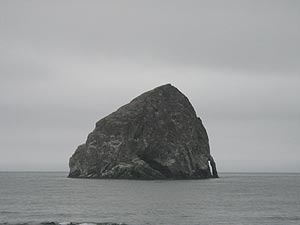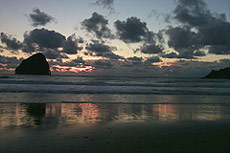 |
Freaky Oregon Coast Facts: Geology of Pacific City's Haystack Rock
Published 06/01/2010
(Pacific City, Oregon) – It's been an Oregon landmark for - well, millions of years - scores more decades than Euro-descended tourists have been around to gawk at it or consider it a favorite.
There are two Haystack Rocks along the Oregon coast: one at Cannon Beach and a slightly less famous one at Pacific City. They both have their mysteries, but the one at Pacific City is finally seeing the light of day as Oregon Coast Beach Connection went digging for answers with Oregon geologists.
One local tourism entity has claimed the Pacific City seastack is one of the largest in the world. That, if you’ll excuse the pun, is still up in the air.
But just how tall is Pacific City's Haystack Rock?
“The rock has an estimated height of 340.6 feet (103.8 m) as determined from Lidar data collected by our agency last year,” said Jonathan Allan, Coastal Geomorphologist and Coastal Section Team Leader with Oregon Department of Geology and Mineral Industries, in their Newport office.

And what is the origin of this grand structure?
Geologists aren’t completely sure – but about 95 percent sure – that it’s part of a massive lava flow that came searing through the northwest millions of years ago. This was the Miocene era, about 23 million years to five million years ago.
They call this the “Columbia River basalts,” which means it’s essentially the same basalt flow that created the Gorge.
“The lithology of the rock is definitely basalt and is probably part of the Grande Ronde basalt formation that is characteristic of Cape Lookout,” Allan said. “However, since we are not aware of any chemical analysis having been done on the basalt, I am not completely sure."
 Seaside-based geologist Tom Horning said it’s the “same as nearly all other sea stacks and mountains south of the Columbia River.”
Seaside-based geologist Tom Horning said it’s the “same as nearly all other sea stacks and mountains south of the Columbia River.”
Horning adds:
“I personally believe it is the remains of a canyon-filling lava that followed the ancient Nestucca River to the ocean.”
In other words, there was a canyon in this spot at one time, and the lava flow was so huge it filled it. Eventually, the area that formed that canyon was eroded away, leaving just structures like Cape Lookout and whatever basalt formation was once connected to what we now know as Haystack Rock. Eventually, all that was worn away to leave Haystack and Lookout in their current forms.
 Haystack Rock in Cannon Beach is actually known as an “instrusive,” meaning the lava flow that it’s a part of shot its way back into the ground, probably in softer ground like mud or such, and then re-erupted again a ways away. This left blob structures that were eventually worn down into shapes we know today like the ones around Cannon Beach.
Haystack Rock in Cannon Beach is actually known as an “instrusive,” meaning the lava flow that it’s a part of shot its way back into the ground, probably in softer ground like mud or such, and then re-erupted again a ways away. This left blob structures that were eventually worn down into shapes we know today like the ones around Cannon Beach.
There may be further investigations into Pacific City’s intriguing monolith, and some more answers.
“I have proposed getting a permit to boat out to the rock and scope it or climb it,” Horning said.
More About Pacific City lodging.....
More about Pacific City, Oceanside dining, restaurants.....
 |
 |
 |
LATEST OREGON COAST NEWS STORIES
Oregon Coast, Valley and Likely Washington Coast to Get Some Aurora Borealis ... |
Back to Oregon Coast Beach Connection
Contact Advertise on BeachConnection.net
Secrets of the Season |
Unusual Travel Articles TravelParanormal.com allows you to submit your own creepy tale or debunk one - or see up-to-the-minute news headlines about travel and the paranormal. News Headlines from All Over Oregon Need to scan Oregon headlines? Constantly updated news from all over Oregon: a comprehensive, up-to-the-minute display of news headlines from a variety of media |



































